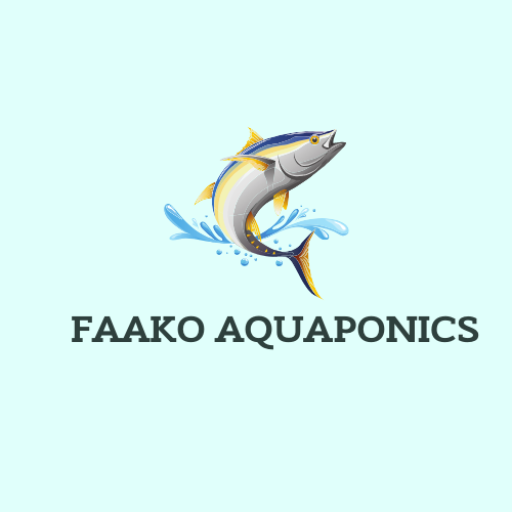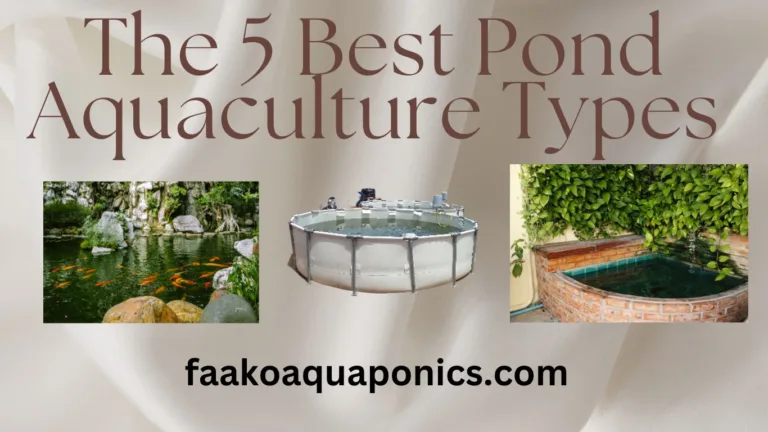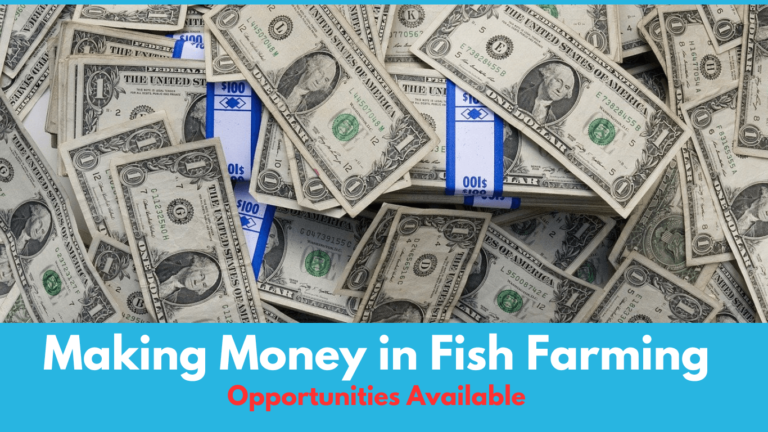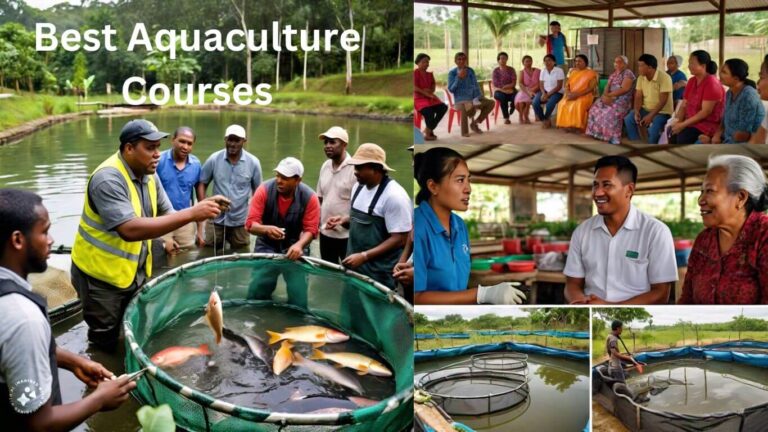Welcome to the world of Pond Aquaculture, where innovation meets tradition to cultivate sustainable aquatic ecosystems. From ancient earthen ponds to modern plastic or rubber enclosures, pond aquaculture consists of a diverse array of practices intended to nurture fish populations while promoting environmental stewardship.
In this guide, we’ll explore the different types of pond aquaculture, and their unique characteristics, advantages, and what to consider before selecting any type of Pond Aquaculture, empowering you to embark on your journey into the amazing idea of fish farming.
1. Earthen or Open Ponds
In the land of aquaculture, where innovation meets tradition, one method has stood the test of time: earthen ponds. These natural reservoirs dug into the earth with careful consideration, have been a cornerstone of aquatic farming for centuries. In this article, we delve into the essence of earthen ponds, examining their definition, what to consider before selecting a site, advantages, and disadvantages of earthen ponds.
What are Earthen Ponds?
Earthen Ponds, as the name suggests, are shallow water bodies formed by excavating or digging soil. They can vary in size, from small backyard ponds to expansive commercial operations spanning acres of land. Typically, these ponds are constructed in areas with suitable soil conditions and water sources, allowing for optimal aquaculture practices.
Advantages of Earthen Ponds
1. Natural Habitat Mimicry
Earthen ponds replicate natural aquatic ecosystems, fostering a conducive environment for aquatic organisms. The soil composition, coupled with natural sunlight and water flow, creates a habitat that promotes the growth and health of various aquatic species.
2. Cost-Effectiveness
Compared to other aquaculture methods, such as concrete tanks or raceways, earthen ponds are often more cost-effective to construct and maintain. The primary materials required are soil and water, making them accessible to a wide range of farmers and enthusiasts.
3. Biodiversity Support
Earthen ponds support a diverse range of flora and fauna. Beyond the targeted fish species, these ponds often host beneficial microorganisms, aquatic plants, and invertebrates, contributing to overall ecosystem health and resilience.
4. Nutrient Recycling
Organic matter and nutrients accumulate in the pond environment over time, creating a natural fertilizer for aquatic plants and phytoplankton. This nutrient-recycling process can enhance water quality and support the growth of fish and other organisms within the pond. Such plants sometimes serve as food for the fish in the pond.
5. Flexibility and Scalability
Earthen ponds offer flexibility in terms of design and scalability. Farmers can adapt pond sizes and configurations based on their specific needs and available resources. Additionally, multiple ponds can be interconnected, allowing for efficient water management and stocking practices.
Disadvantages of Earthen Ponds
1. Vulnerability to Environmental Factors
Earthen ponds are susceptible to environmental fluctuations, such as temperature changes, rainfall, and drought. Extreme weather events or fluctuations in water quality can impact pond ecosystems and potentially disrupt aquaculture operations.
2. Maintenance Requirements
While earthen ponds are relatively low-cost to establish, they require ongoing maintenance to preserve water quality and structural integrity. Regular tasks such as sediment removal, water testing, and bank reinforcement may be necessary to ensure optimal pond conditions.
3. Disease Management
In densely populated ponds, there is an increased risk of disease outbreaks among fish populations. Proper disease management strategies, including regular monitoring, biosecurity measures, and veterinary intervention, are essential to control potential risks.
4. Limited Control
Unlike controlled environments such as indoor recirculating systems, earthen ponds offer limited control over factors such as water temperature, dissolved oxygen levels, and predator access. While natural processes govern pond dynamics, they may also pose challenges in certain situations.
5. Regulatory Considerations
Depending on the location and scale of operations, earthen pond aquaculture may be subject to regulatory requirements and permits. Compliance with environmental regulations, water use permits, and zoning ordinances is essential to ensure legal operation and environmental stewardship.
Factors To Consider When Selecting a Site for Earthen Ponds
I. Soil Composition
Evaluate the soil type and quality to ensure it provides adequate support and stability for pond construction. The soil should have water water-holding capacity.
II. Water Source
Consider the availability and quality of water sources such as groundwater, surface water, or well water for filling and maintaining the pond. Please consider testing the water with the Right Test Kit before using it for your fish farming.
III. Topography
Assess the land elevation and slope to determine suitability for pond construction and potential water runoff or drainage issues.
IV. Climate and Weather Patterns
Consider local climate conditions, including temperature fluctuations, rainfall patterns, and wind exposure, to ensure optimal pond management and fish health.
V. Accessibility
Ensure the site is easily accessible for construction, maintenance, and harvesting activities, including transportation of equipment, supplies, and harvested fish.
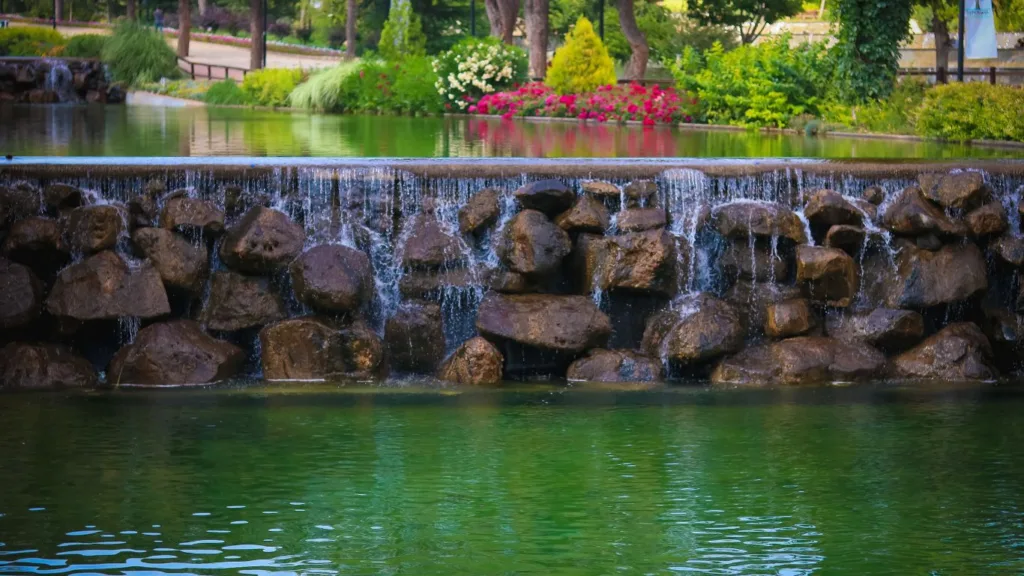
Earthen Pond
2. Concrete Fish Ponds
In the practice of aquaculture, innovation often takes the form of blending traditional practices with modern technology. Concrete fish farming ponds exemplify this fusion, offering a robust solution to sustainable aquatic cultivation. In this article, we explore the definition, advantages, and potential drawbacks of concrete fish farming ponds, shedding light on their role in shaping the future of aquaculture.
What are Concrete Fish Farming Ponds
Concrete fish farming ponds are engineered water bodies constructed using blocks, cement, and other building materials. These ponds are meticulously designed and built to meet specific requirements for aquatic cultivation. The impermeable nature of concrete prevents seepage and provides structural stability, offering a controlled environment for fish farming.
Advantages of Concrete Fish Farming Ponds
1. Structural Integrity
Concrete ponds offer unparalleled structural stability and longevity compared to earthen ponds. The durable construction withstands environmental stressors, such as fluctuating water levels and ground movement, ensuring long-term reliability and performance.
2. Customization and Standardization
Concrete ponds can be customized to suit various aquaculture needs, including size, shape, and depth. Standardized designs streamline construction processes, allowing for efficient replication and scalability across different farming operations.
3. Disease Management
The impermeable nature of concrete minimizes the risk of contamination from external sources, reducing the likelihood of disease outbreaks among fish populations. This enhanced biosecurity promotes a healthier and more resilient farming environment.
4. Water Quality Control
Concrete ponds offer greater control over water quality parameters, such as pH, oxygen levels, and temperature. Integrated filtration and aeration systems facilitate efficient water circulation and treatment, optimizing conditions for fish growth and productivity.
5. Regulatory Compliance
Concrete fish farming ponds often meet regulatory standards and permit requirements more easily than earthen ponds. The engineered construction and standardized practices demonstrate a commitment to environmental stewardship and compliance with industry regulations.
6. Easy Sorting
Concrete Ponds make it easy for sorting to be done in your fish farm to maximise production and reduce cannibalism
Disadvantages of Concrete Fish Farming Ponds
1. High Initial Cost
Constructing concrete ponds typically involves higher upfront costs compared to earthen ponds. The expenses associated with materials, labor, and equipment may pose a barrier to entry for small-scale farmers or those with limited financial resources.
2. Environmental Footprint
The production and installation of concrete materials have environmental implications, including energy consumption and carbon emissions. Additionally, concrete ponds may disrupt natural landscapes and habitats, requiring careful consideration of ecological impacts.
3. Maintenance Requirements
While concrete ponds offer durability, they also require regular maintenance to prevent deterioration and ensure optimal performance. Tasks such as cleaning, repair of cracks or damage, and periodic coating applications are essential to prolong the lifespan of the pond infrastructure.
4. Limited Flexibility
Once constructed, concrete ponds have limited flexibility for modifications or adjustments compared to earthen ponds. Changes in pond design or layout may entail significant time, effort, and expense, potentially limiting adaptability to evolving farming needs.
5. Energy Consumption
The operation of filtration and aeration systems in concrete ponds may require significant energy inputs, contributing to operational costs and environmental impact. Implementing energy-efficient technologies and management practices can help mitigate these concerns.
Factors to Consider When Selecting a Site for Concrete Ponds
I. Land Stability
Ensure the site has stable ground conditions capable of supporting the weight of concrete structures and resisting settlement or subsidence.
II. Water Supply
Verify the availability and quality of water sources for filling and circulating within the concrete ponds, considering factors such as flow rate and water chemistry. Is important to consider testing the water with the Right Test Kit before using it for your fish farming.
III. Permitting and Regulations
Determine if the site complies with local regulations, zoning ordinances, and environmental permits for constructing and operating concrete fish farming ponds.
IV. Utilities and Infrastructure
Assess the availability of essential utilities such as electricity, water supply, and drainage systems needed for pond operation and management. But you may also consider using solar energy to power your fish farm.
V. Future Expansion
Consider the potential for future expansion or modification of the fish farming operation and ensure the site can accommodate additional pond construction or infrastructure development.
Recommendation: Consider lining your concrete pond with a liner to avoid cement chemicals and also the hard surface scratching the fish.
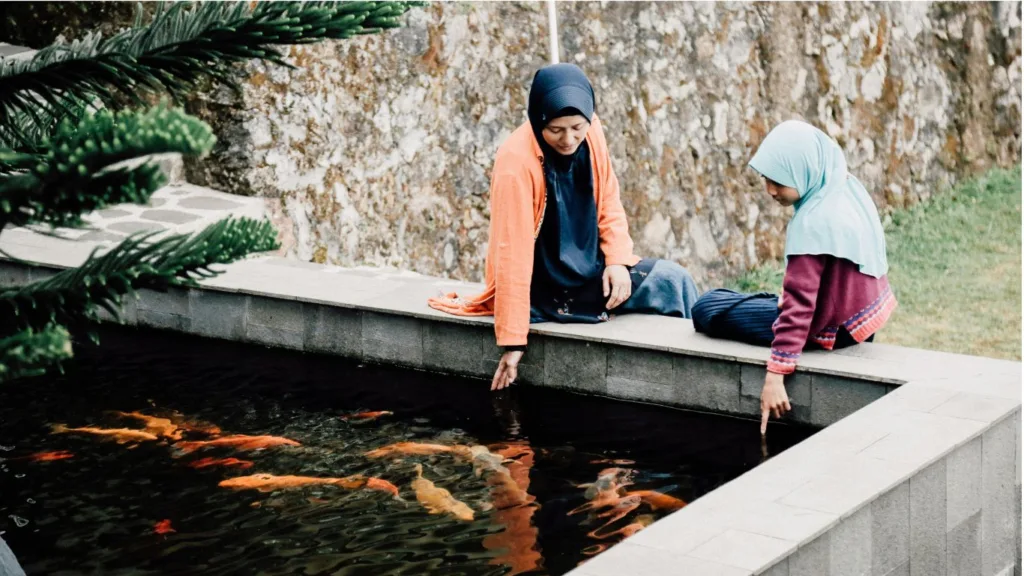
Concrete fish pond
3. Tarpaulin Fish Ponds
In the dynamic landscape of aquaculture, innovation knows no bounds. Tarpaulin fish farming ponds stand as a testament to this spirit, offering a flexible and cost-effective solution to sustainable aquatic cultivation. In this article, we delve into the definition, advantages, and disadvantages of tarpaulin fish farming ponds, and factors to consider before selecting a site for Tarpaulin Fish Pond
What are Tarpaulin Ponds
Tarpaulin fish farming ponds, also known as geomembrane ponds or plastic-lined ponds, are temporary or semi-permanent water enclosures formed by securing a tarpaulin or geomembrane liner to a supportive framework. These lightweight and portable structures provide a versatile alternative to traditional earthen or concrete ponds, offering greater flexibility in terms of setup, relocation, and scalability.
Advantages of Tarpaulin Fish Farming Ponds
1. Cost-Efficiency
Tarpaulin ponds are significantly more affordable to establish compared to conventional pond construction methods. The primary materials – tarpaulin or geomembrane liners – are cost-effective and readily available, reducing initial investment and operational expenses.
2. Mobility and Adaptability
Tarpaulin ponds are portable and can be easily dismantled, relocated, or resized as needed. This flexibility allows farmers to optimize land use, respond to changing environmental conditions, and explore new farming opportunities without the constraints of fixed infrastructure
3. Rapid Deployment
The assembly and installation of tarpaulin ponds require minimal time and labor compared to permanent pond structures. Farmers can quickly deploy these ponds in response to seasonal demands, market fluctuations, or emergencies, maximizing production efficiency.
4. Water Conservation
Geomembrane liners prevent seepage and minimize water loss, promoting efficient water use and conservation. This feature is particularly beneficial in regions prone to water scarcity or where water resources are limited, enhancing sustainability and resource stewardship.
5. Disease Management
Tarpaulin ponds offer a hygienic and controlled environment for fish farming, reducing the risk of disease transmission and contamination. The impermeable nature of geomembrane liners prevents pathogens from entering the pond, promoting fish health and productivity.
Disadvantages of Tarpaulin Fish Farming Ponds
1. Durability Concerns
Tarpaulin materials may degrade over time due to exposure to UV radiation, abrasion, or punctures, compromising pond integrity and lifespan. Regular inspection, maintenance, and timely repairs are essential to mitigate potential durability issues.
2. Vulnerability to Environmental Factors
Tarpaulin ponds are susceptible to damage from extreme weather events, such as strong winds, heavy rainfall, or hailstorms. Adequate site selection, anchoring, and protective measures are necessary to minimize the risk of structural damage and loss.
3. Limited Structural Support
Tarpaulin ponds rely on a supportive framework, which may impose constraints on pond size, depth, and water volume. Careful design and reinforcement are required to ensure structural stability and prevent collapse under load or pressure.
4. Temperature Regulation
Geomembrane liners lack thermal insulation properties, leading to fluctuations in water temperature within tarpaulin ponds. This may impact fish metabolism, growth rates, and overall performance, necessitating additional measures for temperature regulation and management.
5. Regulatory Considerations
Depending on local regulations and permitting requirements, the use of tarpaulin fish farming ponds may be subject to restrictions or oversight. Compliance with environmental regulations, water use permits, and zoning ordinances is essential to ensure legal operation and environmental responsibility.
Factors To Consider Before Selecting A Site For Tarpaulin Fish Pond
i. Flat Ground
Select a level and stable site with minimal slope to facilitate proper installation and support of tarpaulin ponds without risk of structural failure or water leakage.
ii. Water Quality
Ensure access to clean and reliable water sources for filling and replenishing the tarpaulin ponds, considering factors such as water chemistry, temperature, and flow rate. Consider testing the water with the Right Test Kit before using it for your fish farming.
iii. Sunlight Exposure
Evaluate the site’s exposure to sunlight to determine if shading or protective measures are needed to prevent excessive heating of the water and potential algae growth.
iv. Protection from Hazards
Assess potential risks such as flooding, strong winds, or debris accumulation that could damage or compromise the integrity of the tarpaulin ponds, and take appropriate precautions.
v. Land Tenure
Clarify ownership or lease agreements for the site and ensure compliance with any legal or regulatory requirements for using the land for aquaculture purposes.
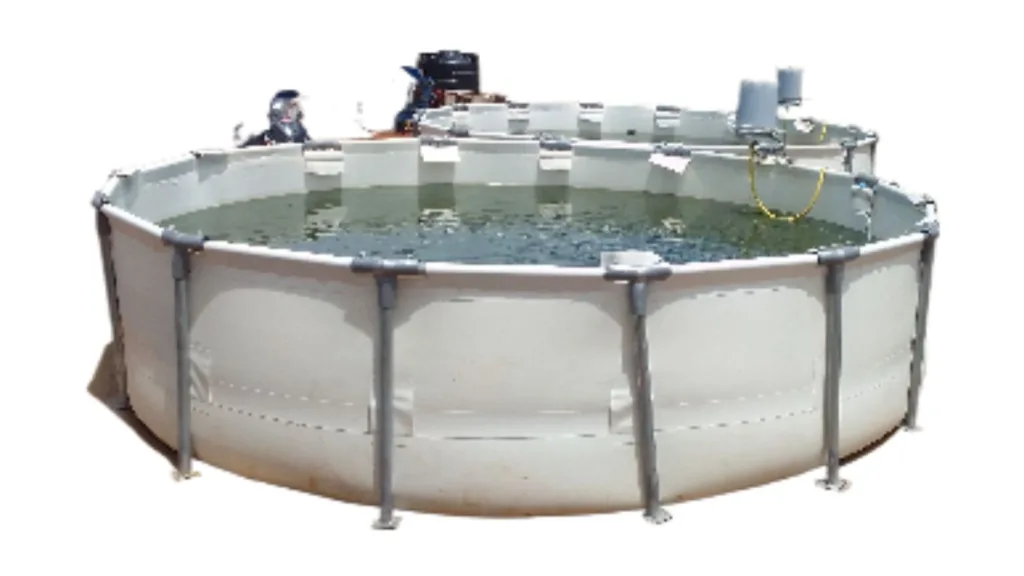
Tarpaulin fish pond
4. Plastic or Rubber Pond
In aquaculture, innovation continues to drive progress. Plastic or rubber ponds have emerged as a contemporary solution, revolutionizing the way we approach fish farming. In this blog post, we’ll delve into the definition, advantages, and potential drawbacks of plastic or rubber ponds, shedding light on their role in shaping the future of aquatic cultivation.
What are Plastic or Rubber Ponds
Plastic or rubber ponds, also known as polyethylene or PVC ponds, represent a modern approach to pond aquaculture. These ponds are constructed using durable, impermeable materials such as high-density polyethylene (HDPE) or reinforced PVC, forming a secure enclosure for fish cultivation. Unlike traditional earthen ponds, plastic or rubber ponds offer greater flexibility, reliability, and ease of maintenance.
Advantages of Plastic or Rubber Ponds
1. Durability and Longevity
Plastic or rubber ponds boast exceptional durability and resistance to environmental stressors. The high-quality materials used in their construction, such as HDPE or PVC, ensure longevity and structural integrity, minimizing the need for frequent repairs or replacements.
2. Leak-Proof Design
The impermeable nature of plastic or rubber liners prevents water seepage, reducing the risk of water loss and ensuring efficient water management. This feature is particularly beneficial in regions with porous soils or fluctuating water tables, enhancing water conservation and sustainability.
3. Easy Installation and Maintenance
Plastic or rubber ponds are relatively easy to install and require minimal maintenance compared to traditional pond structures. The lightweight and flexible nature of liners facilitates quick assembly, while routine cleaning and inspection help maintain water quality and fish health.
4. Versatility in Design
Plastic or rubber ponds offer versatility in terms of design, allowing for customization based on specific aquaculture needs and site conditions. Farmers can adjust pond size, shape, and depth to optimize space utilization and maximize production efficiency.
5. Biosecurity and Disease Management
The smooth, non-porous surface of plastic or rubber liners inhibits the growth of algae, biofilm, and pathogens, reducing the risk of disease transmission among fish populations. Enhanced biosecurity measures promote a healthier and more resilient farming environment.
Disadvantages of Plastic or Rubber Ponds
1. High Initial Cost
The cost of plastic or rubber pond construction may be higher compared to traditional earthen ponds. However, the long-term benefits in terms of durability, efficiency, and productivity often outweigh the initial investment.
2. Temperature Regulation
Plastic or rubber liners lack thermal insulation properties, leading to fluctuations in water temperature within the pond. While this may affect fish metabolism and growth rates, supplementary measures such as shading or aeration can help mitigate temperature variations.
3. Environmental Impact
The production and disposal of plastic or rubber materials have environmental implications, including resource depletion and waste generation. Implementing sustainable practices, such as recycling or proper disposal, can minimize the environmental footprint of plastic or rubber pond aquaculture.
4. UV Degradation
Prolonged exposure to sunlight may cause plastic or rubber liners to degrade over time, compromising their structural integrity and lifespan. UV-resistant coatings or protective covers can help mitigate UV degradation and prolong the durability of pond liners.
5. Regulatory Compliance
Compliance with local regulations and permitting requirements is essential when establishing plastic or rubber ponds for aquaculture purposes. Ensuring adherence to environmental standards, water use permits, and zoning ordinances is crucial for legal operation and environmental stewardship.
Factors to Consider When Selecting a Site for Plastic or Rubber Ponds
i. Water Source
Verify the availability and quality of water sources suitable for filling and maintaining the plastic or rubber ponds, considering factors such as flow rate, water chemistry, and temperature. Is important to consider testing the water with the Right Test Kit before using it for your fish farming.
ii. Ground Stability
Assess the stability and compaction of the soil to support the weight of the plastic or rubber pond liners and prevent settling or deformation over time.
iii. Sunlight Exposure
Consider the site’s exposure to sunlight and potential shading options to regulate water temperature and minimize UV degradation of the pond liners.
iv. Accessibility
Ensure convenient access to the site for construction, maintenance, and harvesting activities, including transportation of equipment, supplies, and harvested fish.
v. Environmental Considerations
Evaluate potential environmental impacts of the aquaculture operation on surrounding ecosystems, water quality, and wildlife habitats, and implement measures to mitigate adverse effects.
5. Fiberglass Tanks
Fiberglass tanks stand at the forefront of fish farming, offering a modern and efficient solution to pond aquaculture. we’ll delve into the definition, advantages, and potential drawbacks of fiberglass tanks, exploring their transformative impact on the aquaculture industry and factors to consider when selecting a site for Fiberglass Tanks
Meaning of Fiberglass Tanks
Fiberglass Tanks are engineered containers made from reinforced plastic composite materials, typically consisting of layers of fiberglass fabric saturated with resin. These tanks provide a controlled environment for fish farming, offering advantages in terms of durability, versatility, and efficiency. Unlike traditional earthen ponds or concrete tanks, fiberglass tanks offer precise control over water quality parameters, stocking density, and environmental conditions, making them a preferred choice for aquaculture operations worldwide.
Advantages of Fiberglass Tanks
1. Durability and Longevity
Fiberglass tanks are renowned for their exceptional durability and resistance to corrosion, rust, and deterioration. The reinforced plastic composite materials used in their construction ensure longevity and structural integrity, minimizing the need for frequent repairs or replacements.
2. Precise Environmental Control
Fiberglass tanks offer precise control over water quality parameters, including temperature, pH, dissolved oxygen levels, and nutrient concentrations. Integrated filtration, aeration, and monitoring systems facilitate optimal conditions for fish growth, health, and productivity.
3. Space Efficiency
Fiberglass tanks can be customized to various sizes and configurations, optimizing space utilization and scalability. Their compact footprint allows for efficient land use, making them suitable for both small-scale and large-scale aquaculture operations.
4. Biosecurity and Disease Management
The non-porous surface of fiberglass tanks inhibits the growth of algae, biofilm, and pathogens, reducing the risk of disease transmission among fish populations. Enhanced biosecurity measures promote a healthier and more resilient farming environment.
5. Versatility in Design
Fiberglass tanks offer versatility in terms of design and installation options, allowing for above-ground or in-ground setups, indoor or outdoor installations, and standalone or interconnected systems. This flexibility accommodates diverse farming needs and site conditions.
Disadvantages of Fiberglass Tanks
1. High Initial Cost
The cost of fiberglass tanks may be higher compared to traditional pond aquaculture methods such as earthen ponds or concrete tanks. However, the long-term benefits in terms of durability, efficiency, and productivity often outweigh the initial investment.
2. Maintenance Requirements
While fiberglass tanks require minimal maintenance compared to other aquaculture structures, routine cleaning, inspection, and repair are essential to ensure optimal performance and longevity. Proper care and maintenance practices help prevent issues such as biofouling, scaling, or equipment malfunction.
3. Limited Oxygen Exchange
Fiberglass tanks may have a limited surface area for oxygen exchange compared to open-air ponds or raceways. Adequate aeration and circulation systems are necessary to maintain optimal oxygen levels throughout the water column, especially in densely stocked tanks.
4. Temperature Regulation
Fiberglass tanks lack thermal insulation properties, leading to fluctuations in water temperature, particularly in outdoor installations or regions with extreme climates. Supplementary heating or cooling systems may be required to maintain stable temperatures and mitigate stress on fish populations.
5. Regulatory Considerations
Compliance with local regulations and permitting requirements is essential when establishing fiberglass tank aquaculture facilities. Ensuring adherence to environmental standards, water use permits, and zoning ordinances is crucial for legal operation and environmental stewardship.
Factors To Consider When Selecting a Site for Fiberglass Tank
i. Flat and Level Ground
Choose a site with a flat and level surface to ensure proper installation and stability of the fiberglass tanks. Uneven terrain may require additional earthworks or leveling to accommodate the tanks effectively.
ii. Access to Utilities
Ensure access to essential utilities such as electricity, water supply, and drainage systems required for operating the fiberglass tanks. The availability of these utilities will facilitate efficient management and maintenance of the aquaculture system.
iii. Space and Layout
Evaluate the available space and layout options for installing fiberglass tanks, considering factors such as tank size, configuration, and spacing between tanks. Optimize space utilization to maximize the number of tanks while allowing for ease of access and maneuverability.
iv. Environmental Considerations
Consider the potential environmental impacts of the aquaculture operation on surrounding ecosystems, water quality, and wildlife habitats. Implement measures to mitigate adverse effects, such as runoff control, waste management, and habitat preservation.
v. Climate Conditions
Assess local climate conditions, including temperature fluctuations, rainfall patterns, and extreme weather events, to determine the suitability of the site for fiberglass tank aquaculture. Climate-controlled systems may be necessary to maintain optimal conditions within the tanks, especially in regions with extreme climates.
vi. Regulatory Compliance
Ensure compliance with local regulations, zoning ordinances, and environmental permits required for establishing and operating fiberglass tank aquaculture facilities. Obtain necessary permits and approvals from relevant authorities before proceeding with site development.
vii. Security and Safety
Consider security measures to protect the fiberglass tanks from theft, vandalism, or unauthorized access. Implement safety protocols and emergency response plans to mitigate risks and ensure the well-being of personnel and fish populations.
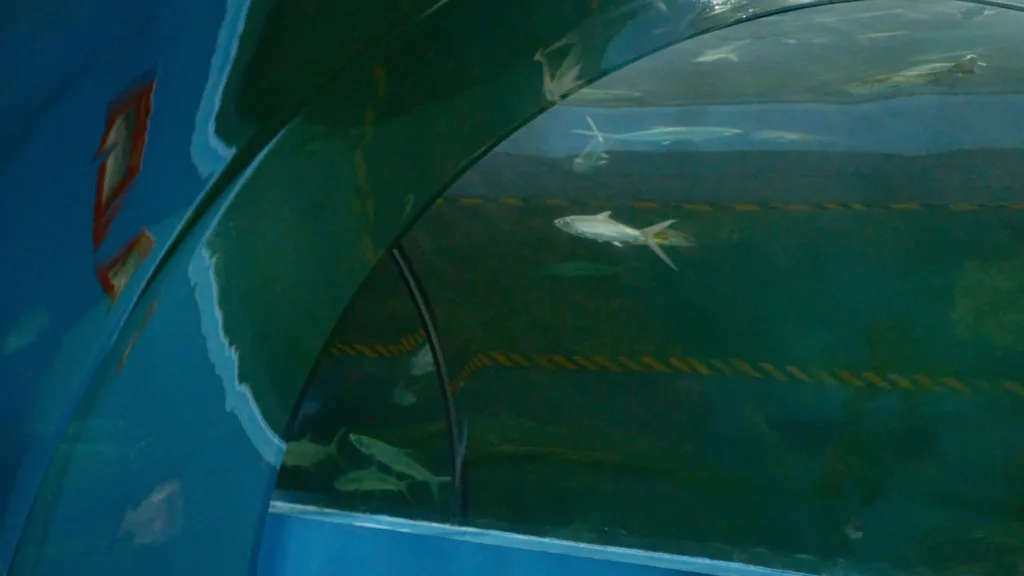
Glass pond
Conclusion
In conclusion, pond aquaculture offers a dynamic and adaptable approach to fish farming, harnessing the natural elements of water, soil, and sunlight to foster thriving aquatic ecosystems. Whether you’re a seasoned farmer or a novice enthusiast, there’s a pond aquaculture method suited to your needs and aspirations. By embracing innovation, sustainability, and best management practices, pond aquaculture holds the promise of a bountiful harvest, a healthier environment, and a brighter future for generations to come.
I will recommend you speak to aquaculture expert for your best pond design.
Frequently Asked Questions (FAQ)
1. Are plastic or rubber ponds suitable for all types of fish farming?
Answer: Plastic or rubber ponds are versatile and can accommodate various types of fish farming, including freshwater and saltwater species. However, it’s essential to consider factors such as water temperature requirements, stocking density, and feeding habits when selecting fish species for aquaculture in these ponds.
2. How long do plastic or rubber pond liners last?
Answer: The lifespan of plastic or rubber pond liners depends on factors such as material quality, environmental conditions, and maintenance practices. High-quality liners made from durable materials like HDPE or reinforced PVC can last 10 to 20 years or more with proper care and maintenance.
3. Can plastic or rubber ponds be used in areas with extreme weather conditions?
Answer: Plastic or rubber ponds are resilient and can withstand a wide range of weather conditions, including heat, cold, and precipitation. However, precautions such as proper anchoring, shading, and protection from strong winds or hailstorms may be necessary to ensure the longevity and integrity of the pond structure.
4. How do I maintain water quality in a plastic or rubber pond?
Answer: Maintaining water quality in plastic or rubber ponds involves regular monitoring and management of parameters such as pH, oxygen levels, and nutrient concentrations. Practices such as water testing, aeration, and filtration can help optimize water quality and promote the health and growth of fish populations.
5. Are plastic or rubber ponds environmentally friendly?
Answer: Plastic or rubber ponds offer advantages in terms of water conservation, efficiency, and biosecurity, but their environmental impact depends on factors such as material production, disposal, and waste management. Implementing sustainable practices, such as recycling, proper disposal, and minimizing resource use, can help mitigate the environmental footprint of plastic or rubber pond aquaculture.
